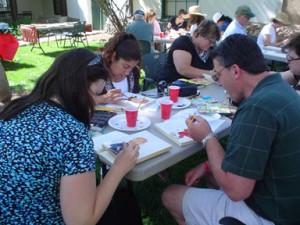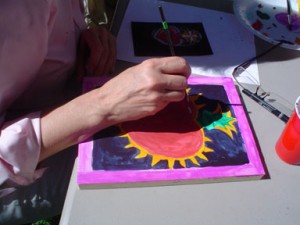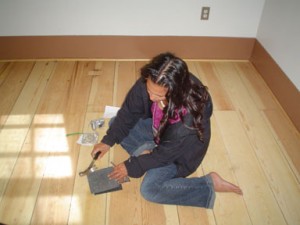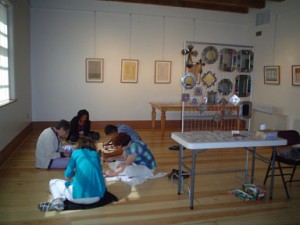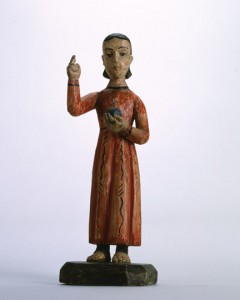 Earlier this year, History Museum Director Frances Levine and Josef Diaz, curator of Southwest and Mexican Colonial Art and History Collections, were in Mexico City, talking to officials at the Museo Franz Mayer about their museum possibly exhibiting some of the retablos and bultos from our Treasures of Devotion/Tesoros de Devoción exhibition. At one point, Director Héctor Rivero Borrell brought out a few retablos he had recently purchased for the Franz Mayer.
Earlier this year, History Museum Director Frances Levine and Josef Diaz, curator of Southwest and Mexican Colonial Art and History Collections, were in Mexico City, talking to officials at the Museo Franz Mayer about their museum possibly exhibiting some of the retablos and bultos from our Treasures of Devotion/Tesoros de Devoción exhibition. At one point, Director Héctor Rivero Borrell brought out a few retablos he had recently purchased for the Franz Mayer.
“He asked what we thought of them,” Diaz recalls. “They were very similar to New Mexican pieces but were not New Mexican. I could tell they were not made in New Mexico.”
At that moment, the seed of a future exhibition took root.
In a grand partnership resembling the mash-up of three U.S. museums and a Spanish museum behind last year’s exhibition, The Threads of Memory: Spain and the United States, the History Museum is now partnering with the Franz Mayer, the Museum of Spanish Colonial Art in Santa Fe, and the San Antonio (Texas) Museum of Art for yet another bi-national exhibition. We recently received a $23,000 convening grant from the Terra Foundation for American Art in Chicago to lay the groundwork for a collaborative exhibition on the art of santos, one of the most definining art forms of this region.
(Santos are carved and painted images of saints. Santeros are the people who create them. Santos include bultos, three-dimensional figures, like the one above, and retablos, two-dimensional pieces painted on wood, like the one below. Both of these santos are from Treasures of Devotion.)
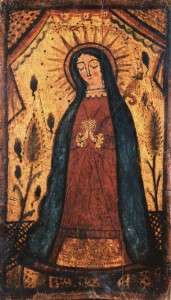 “ Images of saints that are manufactured like this are often treated like stepchildren in Mexico because they’re not done in the academic tradition,” Diaz said. “They’re a little naive in how they’re painted.”
“ Images of saints that are manufactured like this are often treated like stepchildren in Mexico because they’re not done in the academic tradition,” Diaz said. “They’re a little naive in how they’re painted.”
When he and Levine saw the Franz Mayer pieces, Diaz recalls, “We thought maybe they were produced along the Camino Real corridor, outside of the academic center, where they didn’t have the formal schools but were aware of the academic training. Maybe they were a prelude to what was being made in New Mexico along the corridor.”
With the grant, the museums are looking at the larger picture of the art of santos and may revise historical interpretations of the tradition from the mid-18th century to the first quarter of the 20th century in New Mexico, using works from the New Mexico History Museum/Palace of the Governors, Museum of Spanish Colonial Art, other museums and private collections.
The plan is to mount an exhibit that will illustrate how the art form developed as it moved beyond the academic center of Mexico City into the colonial “wilds” of northern New Spain. Were different native materials used? Did the long distance and relative isolation affect santeros’ artistic interpretations? By juxtaposing Mexican and New Mexican devotional pieces, organizers hope to emphasize their connections in terms of style and religious conviction.
“Maybe these Mexican pieces can fill in the scholarly gap between Mexico City’s and northern New Mexico’s styles,” Diaz said. “We know that there was a strong artistic connection along the Camino Real, and this makes me think that these pieces are predecessors to what was eventually made in New Mexico.”
Anyone who’s visited Santa Fe during Spanish Market knows that this artistic tradition is still a vibrant part of the lives of Hispanic communities in New Mexico. To emphasize that, the exhibition will include a sampling of modern works.
The exhibit is anticipated to run from 2015 through 2016. It will first travel to Mexico City, then San Antonio, and finally to the Palace of the Governors.
In July, museum directors and scholars from Mexico, Texas, Colorado, and New Mexico gathered at the History Museum to begin their planning. Attendees brought their expertise on santos and Mexican religious craftsmanship. The group visited the Palace of the Governors, Museum of Spanish Colonial Art, and Museum of International Folk Art to begin assembling a collection for the exhibit. They also discussed conceptual material and a research plan to move the project forward.
Next step? The group reconvenes in Mexico City in October.




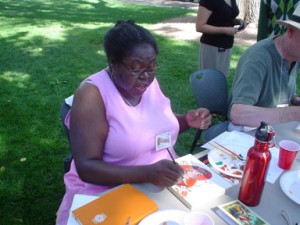 The Palace Courtyard was cool, with a reasonable amount of shade this morning — a far cry from the lightning storm predicted for later today. A perfect time, in short, to try out a little plein air painting, New Mexico-style. The teachers participating in this week’s
The Palace Courtyard was cool, with a reasonable amount of shade this morning — a far cry from the lightning storm predicted for later today. A perfect time, in short, to try out a little plein air painting, New Mexico-style. The teachers participating in this week’s 